Install the app
How to install the app on iOS
Follow along with the video below to see how to install our site as a web app on your home screen.

Anmerkung: This feature currently requires accessing the site using the built-in Safari browser.
Du verwendest einen veralteten Browser. Es ist möglich, dass diese oder andere Websites nicht korrekt angezeigt werden.
Du solltest ein Upgrade durchführen oder einen alternativen Browser verwenden.
Du solltest ein Upgrade durchführen oder einen alternativen Browser verwenden.
Velomobile design, engineering questions
- Ersteller viznz2
- Erstellt am
- Beiträge
- 4.582
I think it is quite logical that the layup data is not shared. It is after all a strange situation that nearly all commercial build velomobiles are build in the same factory, by the same people. Wich one is faster is highly debated, and argumented about. Not all arguments are reliable and sometimes get deformed. exposing such details might lead to whole lot more half informed arguments. Daniel Fenn educated lots of those ladies in laminating techniques. He has a very intuitive understanding how carbon and fiberorientation works. With his velomobiles it is often more difficult to see the reinforcements as they are in the laminate and in shape. With velomobiles like the Milan MK7 and the Bülk u can see clearly several reïnforcements. Looking at the Milans, u can see the evolution from the M2 to the MK 7 and then the next step with the Bülk.
The use of Innegra and another material (nylon?) as a saftey layer, between the carbon, is another important step in making velomobiles safer. They have different properties and help to keep things together after impact.
I can say that huge parts of the surfaces of velomobiles are very thin laminates. On the old Fibreglass Quests, the nose would dent in if you would put a heavy teamug on it. Even on modern velomobiles there are many surfaces u can move in with mild finger presure. Other parts are solid Carbon, like the ear on wich the rear suspension mounts in the Alpha's.
A velomobile is a unibody. On a unibody car many of the bodypanels are very thin and not realy structural. Underneath there is a structure of often hollow shapes, chambers, channels that provide the real strenght. It is comprehensible how forces flow from one part to another. The WAW has a similar structure with ribs. Early Milans did not have that, later ones did. The Evo K was one of Daniels first ones, and it has in the rear a very clear hoop. But his designs evolved and now he can do without a visible hoop there.
The wheelwells and the bridge between them are structural, the chaintunnel is, the nose mount of the beam is a structural part, including the shell area that accepts it, the front side of the rear wheelwell is also a structural part. As is the edge of the entryhole, the hump behing the head, that also acts as a rollbar. The lower side corners are also very important.
On my plywood velomobile the entire shell is made from 1,5mm birchply. There are two 5mm thick and 40mm wide strips of cheap fir lenghtwise to connect the curved corner sections. The upper and lower corners. The entry hole has sides of 20x20mm square beechwood. That is mounted diamond position, and the inner corner is rounded off significantly. On the floor in the corners there is a single layer of very thick Carbon cloth. 370, 400gram there about. That is enough. There is movement in the shell under torsion cause i failed to connect the entry hole good enough to other parts. I made a later add on's to connect the rear part to the rear wheelwell. That is made of high quality (Bruynzeel) 3mm Okoume Also strong enough. I lack a good connection between the front of the cockpit hatch to the front wells.
This also provides a bit of reading material. https://cmoder.gitlab.io/velomobil-grundwissen/velomobile_knowledge.html
There was some aerodynamic testing done at a university in the north of Germany. The results do not match with real life facts about the performance of the different models. Even the people that done the testing made disclaimers about the results being inconsitent with the actual situation. I do not think it is the result of poor testing. But most aerodynamic tests simplify the situation, leave out disturbing factors, to get clean results. In reality, with a moving road, inconsistent wind direction, etc the airflow is probably less clear and predictable. Yet that same windtunnel was used in improving the design for the Bülk.
Even with a very high skillset and theoretical knowledge, one can't design and build a fast aerodynamic recumbent without practical experience. The most monumental cockup was team Blue Younder with on paper a perfect Battle Mountain streamliner. http://www.recumbents.com/wisil/whpsc2001/Blue_Yonder_Team.htm
It was simply way to big and even with a very powerfull rider it was outperformed by a 14 year old kid in a realy fast streamliner. There is a more detailed story on that somewhere on the web, but i can't find it quickly. Theoreticaly their skill and performance data was briliant, they failed on lacking practical knowledge and experience, they where not even smart enough to properly check out the competition. Had they done that they would have noticed how much bigger their streamliner was. One can't learn to be a carpenter, just from books. You have to pick up the tools. It is the same here. A computer model won't tell u how much space a rider needs to be able to pedal within a shell. U need to find that out by trying. Among other things. Don't fall in to that pit.
If u want to go realy fast, forget about open wheelwells would be my advise.
Designing and building your own Velomobile is a nice proces, and i have learned a lot from it. @benparke has similar experiences he has made some very good video's about that also. Check out his channel https://www.youtube.com/channel/UC0LEPEHTrUFBAMWYkgnkFDQ/about
One of the things i knew from the start is that i would never get to the level of a good commercial one. Both Ben and I finaly bought a commercial model, and i think we would both say that the commercial one is an overall better product. Building in wood saved both of us from the potentialy very large investments in building a plug, a mold and only then the final Velomobile, as is needed when going with composits alone. The ammounts of material needed for plug and mold areprobably higher than the price of just buying one.
The use of Innegra and another material (nylon?) as a saftey layer, between the carbon, is another important step in making velomobiles safer. They have different properties and help to keep things together after impact.
I can say that huge parts of the surfaces of velomobiles are very thin laminates. On the old Fibreglass Quests, the nose would dent in if you would put a heavy teamug on it. Even on modern velomobiles there are many surfaces u can move in with mild finger presure. Other parts are solid Carbon, like the ear on wich the rear suspension mounts in the Alpha's.
A velomobile is a unibody. On a unibody car many of the bodypanels are very thin and not realy structural. Underneath there is a structure of often hollow shapes, chambers, channels that provide the real strenght. It is comprehensible how forces flow from one part to another. The WAW has a similar structure with ribs. Early Milans did not have that, later ones did. The Evo K was one of Daniels first ones, and it has in the rear a very clear hoop. But his designs evolved and now he can do without a visible hoop there.
The wheelwells and the bridge between them are structural, the chaintunnel is, the nose mount of the beam is a structural part, including the shell area that accepts it, the front side of the rear wheelwell is also a structural part. As is the edge of the entryhole, the hump behing the head, that also acts as a rollbar. The lower side corners are also very important.
On my plywood velomobile the entire shell is made from 1,5mm birchply. There are two 5mm thick and 40mm wide strips of cheap fir lenghtwise to connect the curved corner sections. The upper and lower corners. The entry hole has sides of 20x20mm square beechwood. That is mounted diamond position, and the inner corner is rounded off significantly. On the floor in the corners there is a single layer of very thick Carbon cloth. 370, 400gram there about. That is enough. There is movement in the shell under torsion cause i failed to connect the entry hole good enough to other parts. I made a later add on's to connect the rear part to the rear wheelwell. That is made of high quality (Bruynzeel) 3mm Okoume Also strong enough. I lack a good connection between the front of the cockpit hatch to the front wells.
This also provides a bit of reading material. https://cmoder.gitlab.io/velomobil-grundwissen/velomobile_knowledge.html
There was some aerodynamic testing done at a university in the north of Germany. The results do not match with real life facts about the performance of the different models. Even the people that done the testing made disclaimers about the results being inconsitent with the actual situation. I do not think it is the result of poor testing. But most aerodynamic tests simplify the situation, leave out disturbing factors, to get clean results. In reality, with a moving road, inconsistent wind direction, etc the airflow is probably less clear and predictable. Yet that same windtunnel was used in improving the design for the Bülk.
Even with a very high skillset and theoretical knowledge, one can't design and build a fast aerodynamic recumbent without practical experience. The most monumental cockup was team Blue Younder with on paper a perfect Battle Mountain streamliner. http://www.recumbents.com/wisil/whpsc2001/Blue_Yonder_Team.htm
It was simply way to big and even with a very powerfull rider it was outperformed by a 14 year old kid in a realy fast streamliner. There is a more detailed story on that somewhere on the web, but i can't find it quickly. Theoreticaly their skill and performance data was briliant, they failed on lacking practical knowledge and experience, they where not even smart enough to properly check out the competition. Had they done that they would have noticed how much bigger their streamliner was. One can't learn to be a carpenter, just from books. You have to pick up the tools. It is the same here. A computer model won't tell u how much space a rider needs to be able to pedal within a shell. U need to find that out by trying. Among other things. Don't fall in to that pit.
If u want to go realy fast, forget about open wheelwells would be my advise.
Designing and building your own Velomobile is a nice proces, and i have learned a lot from it. @benparke has similar experiences he has made some very good video's about that also. Check out his channel https://www.youtube.com/channel/UC0LEPEHTrUFBAMWYkgnkFDQ/about
One of the things i knew from the start is that i would never get to the level of a good commercial one. Both Ben and I finaly bought a commercial model, and i think we would both say that the commercial one is an overall better product. Building in wood saved both of us from the potentialy very large investments in building a plug, a mold and only then the final Velomobile, as is needed when going with composits alone. The ammounts of material needed for plug and mold are
- Beiträge
- 4.092
The geometry data and layup plans for the eXXos velo, I would be well pleased to see them. My email is viz(at)xtra.co.nz.
Hey Gregg you should use a PM for your e-mail can you remove it from public view?
- Beiträge
- 4.092
I can only agree with @tieflieger. Financial reasons pushed me to build my first VM in ply, it came out at 3500€ with some very generous sponsors providing parts it cost me personally just over 2000€. You can buy a good used VM for 3500€ in the EU but from where I live I would have to factor in travel expenses and/or transportation from the flat countries. The result was OK (it has crossed France a couple of times) but turned out a little heavy because of a couple of bad decisions I made. That plan could be built to Evolution weight using the correct materials and composants. It will never be fast (tested to 70 km/h +) but it is very comfortable and capable as a vélocamper.
The second build is "because I can" and my desire to see if a lightweight VM can be built from a plan, @efeu325 has proven that a highly skilled woodworker can build light in wood. At the moment it is hovering around the 26.5 kg mark with the body at 11.6 kg. The price of course reflects the components I have chosen - CF struts and tiller from the new Evo-R for example. I expect the final cost to be somewhere around 5500€. During this build I have often asked myself "why didn't you just but a Bülk?"... The weight would of course have been much less using a 1 x 12 rotor drive train and even lighter wheels and tyres.
There is a VM in Nelson area if I remember correctly, maybe you can find him on YouTube. There is also a guy on Wordpress procrastinating in a shed somewhere near you. Pretty 3D pictures but no finished product.
The second build is "because I can" and my desire to see if a lightweight VM can be built from a plan, @efeu325 has proven that a highly skilled woodworker can build light in wood. At the moment it is hovering around the 26.5 kg mark with the body at 11.6 kg. The price of course reflects the components I have chosen - CF struts and tiller from the new Evo-R for example. I expect the final cost to be somewhere around 5500€. During this build I have often asked myself "why didn't you just but a Bülk?"... The weight would of course have been much less using a 1 x 12 rotor drive train and even lighter wheels and tyres.
There is a VM in Nelson area if I remember correctly, maybe you can find him on YouTube. There is also a guy on Wordpress procrastinating in a shed somewhere near you. Pretty 3D pictures but no finished product.
Do you have a lead on that, something to help chase it down.There is also a guy on Wordpress procrastinating in a shed somewhere near you. Pretty 3D pictures but no finished product.
Re my email I have disguise it like that before and never had trouble. But I asked the moderator to remove it via the reporting button, si we'll se.
Hi Gregg,
I'm the guy that made this presentation. You can find it here: https://www.velomobilforum.de/forum/index.php?threads/8-velomobilseminar-2015.37500/post-804665
I hope downloading is still possible - it's been a while. I can provide the geometry data and simple layup plans of my home-build eXXos velomobile if you are interested. This works fine (I still use this VM a lot) but I won't say it can't be improved.
Best regards, Martin
Hey Martin,
Thanks. I had the seminar, but I downloaded it via your link anyway. Download worked fine.
The geometry data and layup plans for the eXXos velo, I would be well pleased to see them.
I'll send a DM with my email. (the moderators may remove the earlier message with my email in it)
Re the issue of whether design methodologies, common solutions, load cases, material properties etc are shared or hidden......As the velomobile design community matures, this may change and become more like the Akafleigs and hobbyist sailplane design/build community.
Regards,
Gregg.
benparke
gewerblich
- Beiträge
- 287
What tieflieger has said is exactly my experience. In your case of course you have the challenge of being in NZ where importation would be quite costly, though entirely possible. Velomobile World has shipped all over the world.
By the time I factored in the cost of build materials, parts, and my own time, I invested easily as much as buying a used velomobile, which is what I did before rebuilding part of my velomobile in carbon fiber to shave off weight. The used one whetted my appetite for what a high-end velomobile could be, and when the opportunity came to further upgrade, I jumped at it.
That used velomobile got hit by a car while leading a test ride last spring and is probably still sitting in a junk yard somewhere. I’ve since ended up becoming a dealer for Velomobile World and just bought two more new Velomobiles and will sell the one I bought last year sometime this spring. Getting into Velomobiles is a slippery slope, but I have no regrets!
By the time I factored in the cost of build materials, parts, and my own time, I invested easily as much as buying a used velomobile, which is what I did before rebuilding part of my velomobile in carbon fiber to shave off weight. The used one whetted my appetite for what a high-end velomobile could be, and when the opportunity came to further upgrade, I jumped at it.
That used velomobile got hit by a car while leading a test ride last spring and is probably still sitting in a junk yard somewhere. I’ve since ended up becoming a dealer for Velomobile World and just bought two more new Velomobiles and will sell the one I bought last year sometime this spring. Getting into Velomobiles is a slippery slope, but I have no regrets!
......l. And this one visualizes the virtual pivoting.
This is a very cool approach, a simple mockup that quickly illustrates. With a vertical strut and wheel at -4deg camber there is about 50mm horizontal (dx) between the rod end center and the contact patch center. His dimension looks more. So, I don't know why the arc he draws is not a projection from the rim. It's displaced inboard.
But very cool.
Some of your other posts are very long. I will find time later. I have to stay disciplined, on topic.
Gregg.
- Beiträge
- 4.092
Velocivelo Velomobile
A blog about lightweight human powered vehicle and velomobile design.
One idea is to find an expat who is relocating to "home" and who has some space in their shipping container. That way you can reduce shipping costs.
There is a good Evolution for sale in Germany at 4500€ which I guess you have seen here on the forum?
No I hadn't noticed that. I hadn't been looking. I had a quick look and did not see any current listings.One idea is to find an expat who is relocating to "home" and who has some space in their shipping container. That way you can reduce shipping costs.
There is a good Evolution for sale in Germany at 4500€ which I guess you have seen here on the forum?
- Beiträge
- 7.432
Take a look:No I hadn't noticed that. I hadn't been looking. I had a quick look and did not see any current listings.
- Beiträge
- 4.092
- Beiträge
- 5.698
or here, for example an E_Sunrider 48V Velomobile for 3.150,00 €
an other possibility is to ask Howard Stevens from Australia, because he is already further to MK4, if he sells (and send) you his MK1.
here a picture of him riding it:
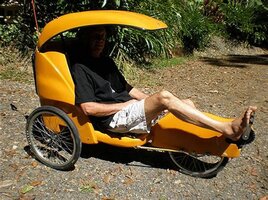
…and so it looks Closed:
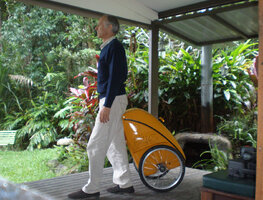
It has even an Luggage-Compartement, were the Luggage can stay in, mevermind if folded or driving.
If you need more Weatherprotection, combine it with an Umbrella like he did with his bike:
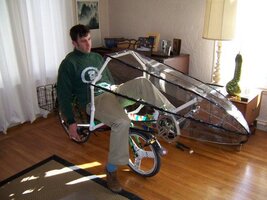
an other possibility is to ask Howard Stevens from Australia, because he is already further to MK4, if he sells (and send) you his MK1.
here a picture of him riding it:

…and so it looks Closed:

It has even an Luggage-Compartement, were the Luggage can stay in, mevermind if folded or driving.
If you need more Weatherprotection, combine it with an Umbrella like he did with his bike:

Zuletzt bearbeitet:
- Beiträge
- 5.698
z. B. http://en.openbike.org/wiki/Python_Trikesmehr Infos zu den Rädern von Howard Stevens
[python] Questions about Howard Stevens foldable Python trike. Anybody any info?
[python] Questions about Howard Stevens foldable Python trike. Anybody any info?, python at FreeLists
www.freelists.org
[python] Re: New Trike Photos from Howard Stevens
[python] Re: New Trike Photos from Howard Stevens, python at FreeLists
www.freelists.org
You guys are having fun derailing my topic.
The questions remain. Especially.......
1) Suspension/steering geometry.
- Camber
- Caster
- King pin inclination
- Toe in/out.
And....
- Akerman angle.
- Scrub radius.
Are there common opinions about ideal geometry for velomobiles?
Are there common tendencies, observable/measurable ?
As I suggested before, from looking at photos, and the drawing of the commonly used Mac strut from velomobeil.nl, there may be some common tendencies. But some practical constraints may be affecting this.....
Approximations....
- Camber -4deg
- Caster +4deg
- King pin inclination 5deg
- Scrub radius... the steering axis will project some distance from the tyre contact patch
Gregg.
The questions remain. Especially.......
1) Suspension/steering geometry.
- Camber
- Caster
- King pin inclination
- Toe in/out.
And....
- Akerman angle.
- Scrub radius.
Are there common opinions about ideal geometry for velomobiles?
Are there common tendencies, observable/measurable ?
As I suggested before, from looking at photos, and the drawing of the commonly used Mac strut from velomobeil.nl, there may be some common tendencies. But some practical constraints may be affecting this.....
Approximations....
- Camber -4deg
- Caster +4deg
- King pin inclination 5deg
- Scrub radius... the steering axis will project some distance from the tyre contact patch
Gregg.
Zuletzt bearbeitet:
These drawings may help..They are paraphrasing ideas taken from photos and the strut drawing from Velomobeil.nl.
I was working on the idea of a sway bar (carbon torsion tube with arms). A version with drop links is in the dwg. I liked the version where the sway bar replaces the front wishbone rod, but I didn't have a good solution yet.
There is a cyan circle drawn at the ends of the kingpin axis and representing the tire contact patch. The camber, castor and kingpin axes are just drawn over the parts, so it is a bit harder to read, but adequate. The tire diameter was wrong when I drew this, but that will have a very small effect.
I loaded the scaled (1:5) pdfs to Dropbox if that may be useful. Let me know if download doesn't work.

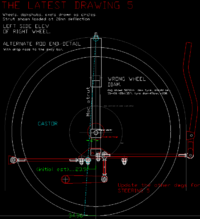
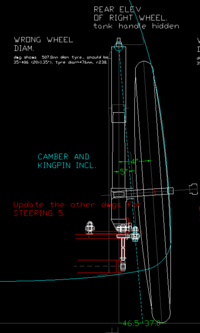
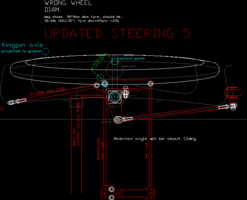
I was working on the idea of a sway bar (carbon torsion tube with arms). A version with drop links is in the dwg. I liked the version where the sway bar replaces the front wishbone rod, but I didn't have a good solution yet.
There is a cyan circle drawn at the ends of the kingpin axis and representing the tire contact patch. The camber, castor and kingpin axes are just drawn over the parts, so it is a bit harder to read, but adequate. The tire diameter was wrong when I drew this, but that will have a very small effect.
I loaded the scaled (1:5) pdfs to Dropbox if that may be useful. Let me know if download doesn't work.



Zuletzt bearbeitet:
- Beiträge
- 5.417
Mag ja sein, aber bei höheren Geschwindigkeiten ist Hecklenkung m. W. immer noch instabiler -manche Zielkonflikte lassen sich aktuell eben noch nicht auflösen.The maximum efficiency of the Tadpole trike in terms of aerodynamics and drive is achieved with front-wheel drive and rear-wheel steering.
Daher ist es m. W. wichtig, vor dem Bau zu wissen, wo die eigenen Prioritäten liegen.
Soweit ich das mitbekommen habe, ist das Gegenteil der Fall:this may change and become more like the Akafleigs
In der Anfangszeit der modernen VM wurde sehr viel Wissen und Erfahrung bereitwillig geteilt (z. B. über die Velomobil-Seminare), seit der Fertigung in Rumänien wird mindestens vonein Entwickler beklagt, daß sein Wissen nun auch den Wettbewerbsprodukten zugute kommt (ohne daß er gefragt wurde).
In der Anfangszeit war es schwierig, mit VM die Unkosten reinzubekommen, mittlerweile können manche sogar davon leben.
Der Vergleich zur Akaflieg paßt daher m. E. nicht mehr.
Übrigens: als Abkürzung für Velomobil empfiehlt sich VM, da Velo in der Schweiz allgemein ein Fahrrad bezeichnet und in diesem deutschsprachigen Forum auch einige Schweizer unterwegs sind.
- Beiträge
- 5.984
I had some thoughts about a sway bar, too.I was working on the idea of a sway bar (carbon torsion tube with arms). A version with drop links is in the dwg. I liked the version where the sway bar replaces the front wishbone rod, but I didn't have a good solution yet.
The thing is this (from my practical observation):
- current velomobiles have a very stiff and short supsension
- it is as stiff and short as necessary so you don't roll and sway too much when pedalling or cornering
- only if you go too soft (like more than 2-3 cm suspension travel) you will have this issue and may introduce a sway bar (which no currently in Romania produced velomobile actually has)
- you can soften your ride by using wider tires with less pressure instead
Only if you have something "offroadish" with much ground clearance and suspension travel you will think again, but that's not what current models actually are.
They are more racing style hard, low and efficient vehicles.
- Beiträge
- 1.131
Ich denke der Lenkrollhalbmesser sollte gegen Null tendieren
